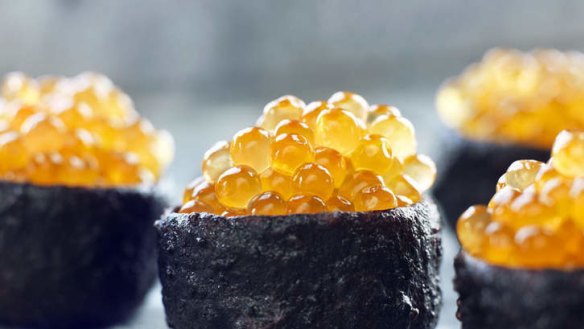Chewing the fat with Magnus Nilsson

The lamb's name was Valdemar, chosen by one of chef Magnus Nilsson's children in reference to a 13th-century Swedish king.
He was the biggest of the eight lambs Nilsson spent a year raising on their family farm, near his tiny, acclaimed restaurant, Faviken, 600 kilometres north of Stockholm.
Valdemar had charisma and Nilsson, in his cookbook Faviken (Phaidon), recounts in bloody detail the Judas moment when the chef took the life of the lamb that recognised him as ''the nice man who usually brought them crushed barley and fed them from his hand''.
Coincidentally, after a 25-year reign, King Valdemar was deposed by his younger brother, Magnus. Nilsson had killed countless animals for meat before but, after shooting the hand-reared lamb with a bolt gun, slitting its throat, watching steam rise from the blood-soaked ground and life drain from Valdemar's eyes, the chef returned home crying.
This was different. As he outlines in the book: ''When you kill an individual that you have come to know and like for your own benefit as food, you gain new respect for the animal, the meat and the process of obtaining it that you cannot get in any other way.''
While Australians are often repulsed by the mistreatment of animals in abattoirs overseas, the kill floor of any abattoir is a traumatically confronting experience for anyone whose main interaction with meat is via polystyrene trays on a supermarket shelf.

Recalling Valdemar over mud crab with XO sauce at Sydney's Mr Wong restaurant, Nilsson says it was a seminal moment that coalesced his views on meat.
The problem, he argues, is that we've become so disconnected from nature it makes us careless.
''I don't mean wild nature and big unspoilt forests, but nature that's close to man: farms, vegetable patches and chickens laying eggs,'' he says.
''Since we don't have that connection, we treat food in a very distant way and don't have to face the reality of what food is.''
Nilsson ponders whether people should be licensed to eat meat, before withdrawing the provocation. ''I don't want very private matters like that decided for us, but it would be good for people if they thought a little more about these things.''
Nonetheless, Nilsson argues, people are eating, and often overeating, with little regard for the circumstances of the animal that ends up on the plate.
''It's not important whether you eat meat, fish or vegetables, which technically is the most sensible option,'' he says.
''It's about the living individual we raise and kill and eat for very selfish purposes.
''If that seems problematic for a consumer, then they might have to rethink the way they consume a little bit.
''If you don't feel good about eating an individual or seeing the hard facts of the production of meat as food, maybe you shouldn't eat it.''
But there's nothing wrong with steak, per se. Nilsson, who turns 30 this year, seems wise beyond his years. He learnt his craft working at Michelin-starred restaurants in Paris, then took a two-year sabbatical after becoming disillusioned with cooking. He then trained as a sommelier, which, in 2008, led him to Faviken, a 12-seat restaurant amid a 10,000-hectare, snow-covered hunting estate in northern Sweden.
By 2011, Nilsson was being hailed, alongside Noma's Rene Redzepi, as one of the rising stars of new Nordic food, and Faviken, which serves dishes such as diced raw cow's heart with moose marrow on a bed of shredded swede, ranks No.34 on the World's 50 Best Restaurants list.
Redzepi and Melbourne chef Ben Shewry are among his friends.
Faviken relies, in part, on the wild harvest as part of its locavore philosophy and embodies the rhythms of the landscape. Nilsson prefers serving meat from grass-fed dairy cows up to 10 years old, and will dry-age meat for up to seven months.
He isn't a fan of wagyu beef, saying it lacks flavour and complexity and is too tender.
''Chewing is an integral part of enjoying food,'' he says.
He returns to his views on our indifferent relationship with food, bringing up a locally vexing issue: the price of milk.
''In the European Union right now, 40 per cent of its annual budget is spent on subsidising agriculture,'' he says.
''One litre of milk costs a euro. It cost the same when I grew up in the early '80s, but the actual cost is €3, but we pay that on the tax bill. I think one of the reasons people waste so much and consume food in a careless way is because they don't see that money, because it's paid via tax, so you lose track of the value of things. If you handed over €3 for a litre of milk, I don't think you'd waste it.''
Then there are other hidden costs?
''By destroying the environment in our search for easier ways of producing more food, we are borrowing from future generations who will have to live with and pay for our mistakes.''
Nilsson also points to a shift in our spending, having grown up in an era when Swedish households devoted 30 per cent of net income to food.
''Today it's something like 10 per cent. We prioritise a new flat-screen TV every three years before eating well and sustainability.''
On Nilsson's second visit to Australia, he tasted his first macadamia nut as well as native finger limes and the berries from the Queensland rainforest tree lemon aspen.
He doesn't like Vegemite, but will happily cook with it, using it to season a beef broth.
''I don't like it on toast the way you guys do. I think you have to be born here for that.''
While he says we eat very well and the produce is excellent, what surprised him is how little Australian chefs know about our native produce.
''It's amazing to see how few Australian chefs look around the landscape to see what's there,'' he says.
''Many people don't seem interested in trying the native ingredients, which is rather sad because the quality is amazing and they tie in with the traditions and culture and history of the place.''
Restaurant reviews, news and the hottest openings served to your inbox.
Sign up